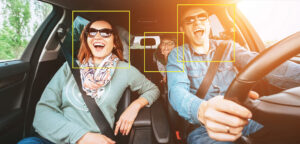
Automotive grade in-cabin lens promises to meet low-light conditions for safety & comfort
By onMarket Trends
Immervision has introduced an “off-the-shelf” in-cabin 190-degree lens for low-light conditions that the company says meets safety and comfort requirements.
The ultra-wide Field of View (FoV) lens offers complete coverage inside the cabin to meet the needs of both driver and occupant monitoring applications. The lens distortion profile is designed to generate image quality and a pixel density targeted for crucial applications to enhance gaze tracking, passenger identification, and hands-on wheel tracking.
“In-cabin monitoring applications are evolving from luxury car options to mandatory safety features and are crucial to autonomous driving systems,” said Jean-Sébastien Landry, Immervision product management director, in a statement. “With our new lens, we can combine more applications in a single camera allowing Tier 1 and OEMs to reduce costs, have a less intrusive in-cabin design, and offer a safer and more enjoyable experience to end users.”
The broadband support, from visible to near-infrared (VNIR), and the lens exceptional capability to capture quality images in low-light, offers versatility for complex monitoring features such as eye tracking through eyeglasses, determining safety hazards such as driver fatigue and improving passenger classification and object detection at night, without external illuminator sources.
Immervision says the camera will allow OEMs to have more complete coverage inside the cabin with fewer cameras and will give them the option to offer new comfort features, such as video chat or conferencing.
The combinations of data from sensors, including video streams from cameras, lidar, radar, ultrasonic, and far infrared (FIR) devices, “provides the driver with additional eyes that constantly scan the vehicle’s surroundings looking for potential problems (like drifting out of lane without first indicating) and dangerous situations (like the vehicle in front suddenly decelerating), Immervision says.
The company notes that the development and adoption of cameras mounted in the dashboard, on the steering column, or integrated into the rear-view mirror to create automotive camera vision systems coupled with artificial intelligence (AI) and machine learning (ML) is “growing exponentially.”
“For example, the AI/ML application could perform facial recognition when the driver’s side door is opened and automatically configure the vehicle accordingly, including things like side and rear mirror positions, driver’s seat settings, even the default radio channel selection,” Immervision says. “…it will also be possible to watch for signs indicating health problems such as a heart attack, stroke, or epileptic fit, in which case the vehicle’s hazard warning lights could be triggered and it could automatically bring itself to a safe stop while also initiating a call to emergency services.”
In October, an analysis published in the tech publication, Embedded, found that the future for driver monitoring systems (DMS) in passenger vehicles looks bright considering legislative and private interest in using the technology to implement semi-automated driving and improve driving safety. The article notes that DMS “will proliferate into passenger vehicles at a substantial rate over the next decade” if regulations currently under consideration in the U.S. and China are eventually enacted.
Two recent examples of new in-cabin tech come from Toyota and Volvo.
In June, Toyota shared details about the development and testing of a new safety feature “Cabin Awareness” concept for its vehicles that uses millimeter-wave, high-resolution 4D imaging radar to help detect occupants in cars and also, potentially, those that are inadvertently left behind.
In 2021, Volvo invested in Spectralics’ optics film for windshields that creates an augmented reality {AR) display screen and could be used in the future to create a wide field of view heads-up display on the windshield with objects superimposed on the real-world background to give a sense of distance.
Images
Featured image credit: Immervision
Immervision’s “off-the-shelf” 190-degree lens promises to address automotive low-light in-cabin requirements for safety and comfort. (Credit: Immervision)
